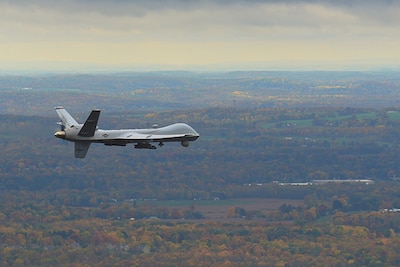By Eric Durr New York National Guard
SYRACUSE, N.Y., Dec. 15, 2017 — Nine members of the New York
Air National Guard’s 174th Attack Wing have deployed to assist the California
Air National Guard’s 163rd Attack Wing in flying the MQ-9 Reaper remotely
piloted aircraft that have been helping local authorities fight the massive Thomas
Fire in Southern California.
The New York airmen, who are based at Hancock Field Air
National Guard Base here, are trained to fly and operate the MQ-9 remotely
piloted aircraft, which is used by the military for surveillance and combat air
patrol missions.
The California Air National Guard has been employing the
MQ-9 as an eye in the sky to support the California Department of Forestry and
Fire Protection and other state agencies responding to the wildfires that have
burned 234,000 acres and destroyed more than 1,000 buildings.
The New York airmen will assist California Air National Guardsmen
who have been stretched thin during this domestic response operation.
“We have been working this fire since [Dec. 5] and have been
working 24-hour operations since then,” said Air Force Maj. Nicholas Edwards,
the director of incident awareness and assessment for the California Air
National Guard’s 222nd Intelligence Support Squadron. “We want to do everything
we can. This is why we join the guard -- to help out our community and our
state.”
‘Glad to Help’
According to Air Force Col. Michael Smith, the commander of
the 174th Attack Wing, “That’s a horrible incident they are dealing with, and
we’re glad to help in any way we can.”
Air National Guard members from the 195th Intelligence,
Surveillance, and Reconnaissance Group analyze full-motion video of the Thomas
Fire and relay their findings to fire crews on the ground
"New Yorkers always help their neighbors in their time
of need, and I thank the members of 174th Attack Wing for representing the very
best of the Empire State spirit as they assist our friends in California,"
New York Governor Andrew M. Cuomo said. "As California works day and night
to stop these fires, New York is proud to provide reinforcements and the use of
advanced technology to help identify where to dispatch firefighting efforts to
end this tragic event."
The MQ-9s have been providing overhead video to fire
managers using sensors that can see through smoke. The aircraft fly at high
altitudes and are not affected by high winds, which can keep helicopters from
operating over fire areas. They also have the ability to loiter over a given
area for over 14 hours.
The full-motion video is used to map the fire lines and
observe fire expansion and progression, Edwards said.
This ability to orbit continuously over a geographic area
provides the incident commander a much clearer picture of the situation and
enables them to make better response decisions, Air National Guard officials
said.
“Having an asset in the air providing persistent observation
is key to fulfilling the incident commander’s needs and crucial in identifying
emerging active fire behavior,” said Air Force Master Sgt. Jason Tyler, chief
of incident awareness and assessment for the California Air National Guard’s
234th Intelligence Squadron. “It allows fire departments to get ahead of it and
take appropriate actions such as evacuating areas which the fire may affect.”
“We help out with damage assessment by getting the number of
destroyed structures out quickly using satellite imagery and comparing it to
imagery from the sensored aircraft,” he said. “Getting the numbers allows
affected counties to get aid they need whether it's from a federal source or
state agencies.”
The 174th Attack Wing deployed three MQ-9 pilots, three
sensor operators -- the airmen responsible for operating the state-of-the-art
cameras and other sensor systems -- and three imagery analysts Dec. 13. The
airmen are due to return home Dec. 22.
This is the first time the wing has deployed its MQ-9
resources in support of civil authorities.
(Editor’s note: Reporting by Air Force Airman 1st Class
Tristan Viglianco contributed to this story.)









